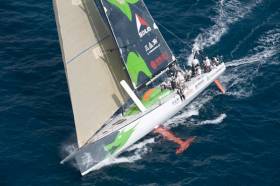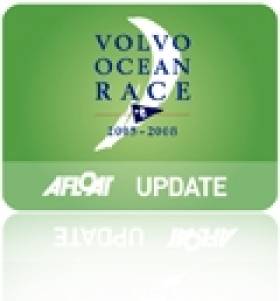Displaying items by tag: Jamie Boag
Jamie Boag Honoured At Atlantic Youth Trust Gala
#JamieBoag - Volvo Ocean Race team commercial boss Jamie Boag was honoured for his contributions to sailing at the Atlantic Youth Trust's conference and dinner in Galway last weekend, as the Galway Independent reports.
The commercial director of Abu Dhabi Ocean Racing – winners of the most recent Volvo Ocean Race – received the trust's Lifetime Achievement Award for his work with its Irish-flavoured predecessor Green Dragon Racing, as well as his hand in bringing the world's most gruelling ocean yacht race to Galway.
Also on the evening last Saturday (12 March), the Galway Independent contributed €5,000 towards a seed fund to develop a bursary for youth sail trainees in the West of Ireland, along the lines of those already established in Drogheda and West Cork.
The day's conference also saw discussions and workshops on the trust's plans to build a new tall ship for Ireland, as previously reported on Afloat.ie.
Neck & Neck to Cape Town in Volvo Ocean Race Leg One Finish
#vor – After 19 days & 3,000 miles sailed in the first leg of the Volvo Ocean Race, the top three teams can still see each other as they approach Cape Town, south Africa and the end of leg one. Irish sailors on two leading teams are blogging about their latest experiences including some good insights from Abu Dhabi Team Director Jamie Boag from Belfast, here.
Also giving a picture of life on board Team Vestas is Brian Carlin, the onboard reporter from County Kerry. His latest onboard account is here.
Abu Dhabi, Team Brunel and Team Vestas Wind are locked against each other with Dongfeng Race Team just 17NM further adrift.
It is unlikely that any boat will gybe away from their starboard course, as this will take them into less wind and point back at North Africa.
Matt Knighton, the OBR onboard Abu Dhabi Ocean Racing, commented: "One might think that after 19 days of racing and being thousands of miles from land we're surprised to see another boat so close. To be honest, we're not.
"The shock of how close this one-design racing is has worn off. After the earlier battle down the African coast, it's not surprising to see one or even two sails keeping pace with you for a very, very long time."
Dongfeng is the most inside boat but, as we have been saying for some days, those closest to the high would trade wind speed for shift.
Right now the trade is not looking like a good one as the lifted inside shift is not paying them with enough wind speed to make the deal work.
Team Alvimedica is on the opposite side of the coin: more wind less shift. Lets see who is right.
Team Vestas Wind is the stalking horse here. So far from passing Fernando, navigator Wouter Verbraak has looked at times like he has lost the plot and others like a tactical genius. Right now, Wouter is looking more right then wrong.
Meantime, at the back of the fleet, it's been tough work.
Team SCA has dropped off the pack in a lot less wind while MAPRFE has been struggling too after suffering water ingress and some electrical issues.






























































